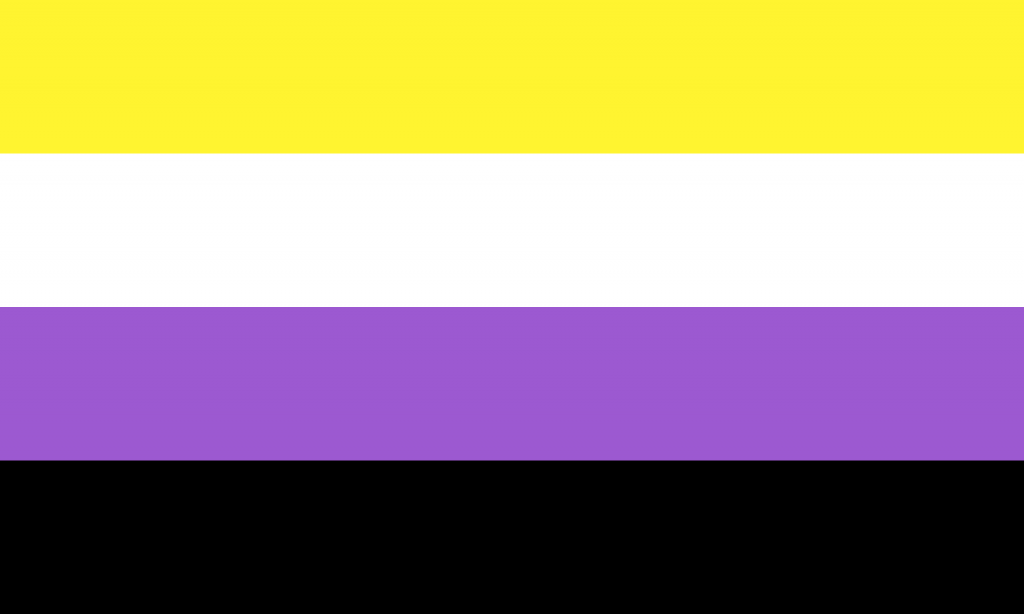
In an effort to remain accountable to communities who have been negatively impacted by past and present medical injustices, the staff at Himmelfarb Library is committed to the work of maintaining an anti-discriminatory practice. We will uplift and highlight diverse stories throughout the year, and not shy away from difficult conversations necessary for health sciences education. To help fulfill this mission, today's blog post celebrates International Non-Binary Day!
July 14th is International Non-Binary Day! The first International Non-Binary Day took place in 2012 (Angulo, 2019). The date falls between International Women’s Day and International Men’s Day, making it an appropriate date on which to raise awareness of people who do not identify exclusively as man or woman. So what is non-binary?
Non-binary refers to anyone whose gender identity isn’t categorized as female or male. While some non-binary people identify as both a man and a woman, others don’t identify with either of these gender categories (HRC Staff, 2020). While some non-binary people identify as transgender, many do not. “Non-binary identities are varied and can include people who identify with some aspects of binary identities, while others reject them entirely” (Stonewall Staff, 2006). Simply put, being non-binary is as unique and individual as the people who identify as non-binary.
We can all be an ally to non-binary people. Some of the simplest things you can do to be inclusive involve being aware of how the language you use can have a positive impact on everyone, regardless of gender identity. Including your pronouns when you introduce yourself, in your email signatures and social media profiles can be a great starting point. When you introduce yourself, saying “Hi, my name is Jane and I use she/her pronouns” can be an easy way for other people to safely introduce their pronouns. This not only lets the person know that you are interested in using their correct pronouns, but also makes it easy for them to communicate their preferences to you if they wish. You may also consider using gender neutral language when you are addressing a group by replacing “ladies and gentleman” with “folks” or “everyone.” When mentioning relationships, consider using gender neutral terms such as parents (instead of father/mother), children (instead of sons/daughters), siblings (instead of brothers/sisters), or partner (instead of husband/wife, boyfriend/girlfriend).
From a medical and health perspective, non-binary people often experience health disparities resulting from their non-binary identities. One qualitative study published in 2020 in the Journal of Sex Research “explored the unique ways that non-binary adolescents experience minority stress and how it influences their mental health and well-being” (Johnson et al., 2020). Identity invalidation (the refusal to accept someone’s identity as “real” or “true”) was experienced during interpersonal relationships, within the LGBTQ communitity, on an institutional level in school environments, and through a lack of representation in the media (Johnson et al., 2020). The data collected from this study suggests that “identity invalidation has deleterious effects on mental health and contributes to mental health disparities facing non-binary adolescents” (Johnson et al. 2020).
A study published in the Journal of Health Care for the Poor and Underserved in 2018 examined interactions between transgender and gender non-binary individuals and their health care providers and identified characteristics of positive and negative interactions. Characteristics of positive clinician-patient interactions included: the correct use of names and pronouns; use of gender neutral language when referencing relationships, anatomy, and procedures; clinician knowledge of and experience with transgender and non-binary health; and treatment of identity disclosure as routine (Baldwin et al., 2018). Characteristics of negative clinician-patient interactions included: misgendering; lack of information and experience with transgender and non-binary patients (which often led to irrelevant questions stemming from clinician curiosity); and transphobia that led to a denial of care or a referral to another provider - another form of denial of care (Baldwin et al., 2018). This study concluded that formal medical education and training programs need to provide education and experience related to gender diverse patients. “Adjusting patient intake protocol and forms at the system-level to incorporate gender-neutral terminology and facilitate the use of preferred names and pronouns” was all supported by this study (Baldwin et al, 2018).
As we celebrate International Non-Binary Day this year, take some time to explore resources such as SMHS’s LGBTQIA+ Community Support page, and GW student groups such as GW Out for Health or Transgender and Non-Binary Students of GWU. One of the best ways to celebrate International Non-Binary Day is through education and learning more about the non-binary experience. The following video is a great starting point - take a look and learn what it’s like to be non-binary.
References:
Angulo, D. (2019, July 15). Between international women’s and men’s day is non-binary day! Outright Action International. https://outrightinternational.org/content/between-international-womens-and-mens-days-non-binary-day
Baldwin, A., Dodge, B., Schick, V. R., Light, B., Scharrs, P. W., Herbenick, D., & Fortenberry, J. D. (2018). Transgender and Genderqueer Individuals’ Experiences with Health Care Providers: What’s Working, What’s Not, and Where Do We Go from Here? Journal of Health Care for the Poor and Underserved, 29(4), 1300–1318. https://doi.org/10.1353/hpu.2018.0097
CBC News: The National (2021, June 28). What it’s like to be non-binary . YouTube. https://youtu.be/7Gr78THojrU
HRC Staff (2020, July 14). Celebrating the Diversity of the Non-Binary Community for International Non-Binary Day 2020. https://www.hrc.org/news/celebrating-the-diversity-of-the-non-binary-community-for-international-non
Johnson, K. C., LeBlanc, A. J., Deardorff, J., & Bockting, W. O. (2020). Invalidation Experiences Among Non-Binary Adolescents. The Journal of Sex Research, 57(2), 222–233. https://doi.org/10.1080/00224499.2019.1608422
Stonewall Staff (2006, July 21). 10 ways to step up as an ally to non-binary people. Stonewall. https://www.stonewall.org.uk/about-us/news/10-ways-step-ally-non-binary-people


